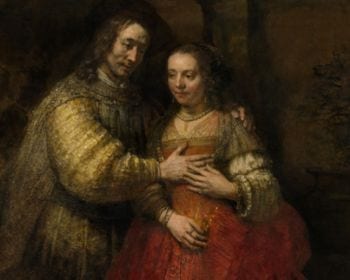The Jewish Hermitage museum is housed in the grand palace, built by Catherine the Great. Its magic is palpable, the grand rooms displaying many of the greatest work by the Old Masters.
The collection was started haphazardly by Peter the Great, but it&rsquos real founder was the energetic and unconventional Catherine II. The empress not only built the building, but began the aquisition of pictures on a large scale. In 1763 she aquired the Gotzkowsky Collection, with it&rsquos Rembrandts and continued to accumulateover 2000 pictures, most of which are examples of the finest classical art in the world. The very last collection was in 1886, by Alexander III.
The collection of Rembrandts is particularly fascinating. There are forty-three pictures put down to Rembrandt, yet some of those, according to mavens, although superb in quality, may have been painted by his students. However, the beauty of the collection speaks clearly of Rembrandt’s ability as a master storyteller. Whether painting portraits, scenes from daily life or stories from the Bible, he delved into the mind and soul of his subjects. He gave flesh to spirit. For his biblical subjects he often used models from the Jewish population of Amsterdam. &ldquoThe Jewish Bride&rdquo in the photo above, is considered one of the greatest masterpieces that achieved immortal fame. Works depicting scenes from the Old Testament and Jewish themed paintings, such as "the sacrifice of Abraham", "The old Jew" "The blinding of Samson", "David and Jonathan, and "David and Uriah","A Rabbi Seated, Stick in his Hand, Feather in his Cap", amongst others, are universally transcending. It’s interesting to note that Rembrandt painted himself as a character in the crowd scenes. It’s assumed that was because the Bible was for him a kind of a diary, a moment in his own life. Also interesting, is that the artist and his wife chose to rent a large and lovely home in what was becoming the up and coming Jewish Quarter, from where he picked most of the models for the biblical scenes, or the magnificent "Picture of an Old Jew".
In his paintings he exhibited a knlowledge of iconography, which he molded to fit his experiences, thus the depiction of the biblical scene was informed by his his knowledge of the specific text and his observation of Amsterdam’s Jewish population. Because of his empathy for the human condition, he had been called "one of the great prophets of civilization" Coming face to face with these breathtaking works of genius, looking into the eyes of his depiction of our ancestors, is a deeply moving experience.
We return to this amazing destination every time we visit The Baltics on a cruise and highly recommend it!

